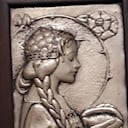What musical instrument is the Greek god Pan associated with?
In Greek mythology, Pan was a fertility deity. He was associated by the Romans with Faunus. Pan was generally represented as a vigorous and lustful figure having the horns, legs, and ears of a goat. The pan flute is named after Pan, the Greek god of nature, and shepherds are often depicted with such an instrument.
Syrinx (“Σύριγξ”) was a forest Nymph. In her attempt to escape the affection of Pan she was transformed into a water-reed or “calamos” (cane-reed). Then, Pan cut several reeds, placed them in parallel one next to the other, and bound them together to make a melodic musical instrument. Ancient Greeks called this instrument “Syrinx”, in honor of the nymph, and “Pandean”, or Pan-pipes and Pan-flute, after Pan.
The Pan Flute (also known as "panpipes" or "syrinx") is a musical instrument based on the principle of the closed tube, consisting of multiple pipes of gradually increasing length (and occasionally girth). Multiple varieties of pan flutes have been popular as folk instruments. The pipes are typically made from bamboo, giant cane, or local reeds. Other materials include wood, plastic, metal, and ivory.
The Syrinx, a predominantly pastoral instrument for the Greeks, was adopted by the Etruscans who played it at their festivals and banquets; the Etruscans called it “fistula”. The Romans adopted the Syrinx from the Greeks and the Etruscans, and they too played it at their banquets, festivals, as well as in religious and funeral processions.
More Info:
en.wikipedia.org








